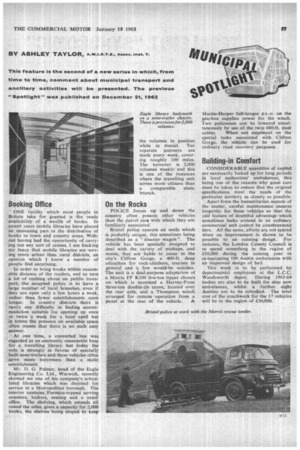Booking Office
Page 59

If you've noticed an error in this article please click here to report it so we can fix it.
ONE facility which most people in Britain take for granted is the ready availability of a wealth of books. In recent years mobile libraries have played an increasing part in the distribution of books to town and country areas. Without having had the opportunity of carrying out any sort of census, I am backing my fancy that mobile libraries are 'serving more urban than rural districts, an opinion which I know a number • of people find surprising.
In order to bring books within reasonable distance of the readers, and so save a lot of rushing about on public transport, the accepted policy 15 to have a
• large number of local branches, even if they are open only a few hours a week, rather than fewer establishments open longer. In country districts there is rarely any difficulty in finding accommodation, suitable for opening up once or twice a week for a brief spell but in towns the pressure on available space often means that there is no such easy answer, At one time, a converted bus was • regarded as an eminently reasonable base for a travelling library but today the vote is strongly in favour of specially built semi-trailers and these vehicles often .serve more borrowers than a static establishment.
Mr. D. G. Palmer, head of the Eagle Engineering Co. Ltd., Warwick, recently showed me one of his company's articulated libraries which was destined for service in a Metropolitan borough. The interior contains Formica-topped serving counters, lockers, seating and a small office. The shelving, which extends all round the sides, gives a capacity for 2,000 books, the shelves being sloped to keep the volumes in position while in transit. Ten separate journeys are made every week, covering roughly 100 miles. The turnover is 2,000 volumes weekly and this is one of the instances where the travelling unit serves more citizens than a comparable static branch.
On the Rocks
POLICE forces up and down the country often possess other vehicles than the patrol cars with which they are familiarly associated.
Bristol police operate an outfit which is probably unique, this sometimes being described as a "disaster wagon ". The vehicle has been specially designed to deal with the variety of mishaps, and worse, that are liable to occur in the city's Clifton Gorge, a 400-ft. deep attraction for rock-climbers, tourists in general and a few would-be suicides. The unit is a dual-purpose adaptation of a Morris FF ICIO0 five-ton tipper chassis on which is mounted a Harvey-Frost three-ton double-jib crane, located over the rear axle, and a Thompson winch arranged for remote operation from a panel at the rear of the vehicle. A Martin-Harper full-torque p.t.-o. on the gearbox supplies power for the winch. Two policemen can be lowered simultaneously by use of the twin 600-ft. steel cables. When not. employed on the special tasks associated with Clifton Gorge, the vehicle can be used for ordinary road recovery purposes.
Building-in Comfort
CONSIDERABLE quantities of capital are necessarily locked up for long periods in local authorities' ambulances, this being one of the reasons why great care must be taken to ensure that the original specifications meet the needs of the particular territory as closely as possible.
Apart from the humanitarian aspects of the matter, careful maintenance ensures longevity for these vehicles so that the odd feature of doubtful advantage which sometimes lurks around in an ordinary commercial unit cannot be countenanced here. All the same, efforts are not spared when an improvement is shown to be possible to an existing design. For instance, the London County Council is to spend something in the region of £10,000 during the coming year in re-equipping 100 Austin ambulances with an improved design of bed.
This work is to be performed by departmental employees at the L.C.C. Wandsworth depot. During 1963-64 bodies are also to be built for nine new ambulances, whilst a further eight Austins are to be rebodied. The total cost of the coachwork for the 17 vehicles will be in the region of £30,000.
































































































